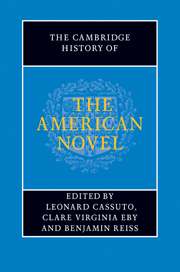Book contents
- Frontmatter
- General Introduction
- PART ONE INVENTING THE AMERICAN NOVEL
- PART TWO REALISM, PROTEST, ACCOMMODATION
- PART THREE MODERNISM AND BEYOND
- Introduction: modernism and beyond
- 37 Stein, Hemingway, and American modernisms
- 38 The Great Gatsby and the 1920s
- 39 Philosophy and the American novel
- 40 Steinbeck and the proletarian novel
- 41 The novel, mass culture, mass media
- 42 Wright, Hurston, and the direction of the African American novel
- 43 Ellison and Baldwin: aesthetics, activism, and the social order
- 44 Religion and the twentieth-century American novel
- 45 Faulkner and the Southern novel
- 46 Law and the American novel
- 47 Twentieth-century publishing and the rise of the paperback
- 48 The novel of crime, mystery, and suspense
- 49 US novels and US wars
- 50 Science fiction
- 51 Female genre fiction in the twentieth century
- 52 Children's novels
- 53 The American novel and the rise of the suburbs
- 54 The Jewish great American novel
- 55 The Beats and the 1960s
- 56 Literary feminisms
- 57 Reimagining genders and sexualities
- PART FOUR CONTEMPORARY FORMATIONS
- A selected bibliography
- Index
49 - US novels and US wars
from PART THREE - MODERNISM AND BEYOND
Published online by Cambridge University Press: 28 July 2011
- Frontmatter
- General Introduction
- PART ONE INVENTING THE AMERICAN NOVEL
- PART TWO REALISM, PROTEST, ACCOMMODATION
- PART THREE MODERNISM AND BEYOND
- Introduction: modernism and beyond
- 37 Stein, Hemingway, and American modernisms
- 38 The Great Gatsby and the 1920s
- 39 Philosophy and the American novel
- 40 Steinbeck and the proletarian novel
- 41 The novel, mass culture, mass media
- 42 Wright, Hurston, and the direction of the African American novel
- 43 Ellison and Baldwin: aesthetics, activism, and the social order
- 44 Religion and the twentieth-century American novel
- 45 Faulkner and the Southern novel
- 46 Law and the American novel
- 47 Twentieth-century publishing and the rise of the paperback
- 48 The novel of crime, mystery, and suspense
- 49 US novels and US wars
- 50 Science fiction
- 51 Female genre fiction in the twentieth century
- 52 Children's novels
- 53 The American novel and the rise of the suburbs
- 54 The Jewish great American novel
- 55 The Beats and the 1960s
- 56 Literary feminisms
- 57 Reimagining genders and sexualities
- PART FOUR CONTEMPORARY FORMATIONS
- A selected bibliography
- Index
Summary
Traditional approaches to the “war novel” and “the literature of war” have focused mostly on cultural reactions to specific wars, accepting a causal relationship that privileges the historical event over its representation. The Civil War takes place, and we have the cultural “response.” Edmund Wilson's famous Patriotic Gore: Studies in the Literature of the American Civil War (1962) is a good example of this approach. Since Paul Fussell's The Great War and Modern Memory (1975), however, the relationship between “war literature” and the “event” of warfare has been treated in a more dialectical manner. Literature and other cultural production may predict war, warn us away from it, prepare us emotionally for it, even help legitimate warfare. Cultural work may also help us understand certain social and political issues as inextricable from violent conflict, even when not identified as specific wars. In focusing only on the Haitian Revolution or the American Civil War, for example, we tend to ignore the long histories of struggle against colonialism and slavery that culminated in warfare. In considering only those wars officially recognized by the US government, we forget the military campaigns waged by the US against native peoples in the course of westward expansion. In thinking conventionally about warfare in political and strategic ways, we also tend to ignore the consequences for non-combatants. In historical periods when women participated in warfare primarily in supporting or defensive roles, their experiences of war were often ignored. By the same token, children and the elderly and other non-combatants figure only in the backgrounds of many classic “war novels.”
- Type
- Chapter
- Information
- The Cambridge History of the American Novel , pp. 813 - 831Publisher: Cambridge University PressPrint publication year: 2011
- 1
- Cited by

